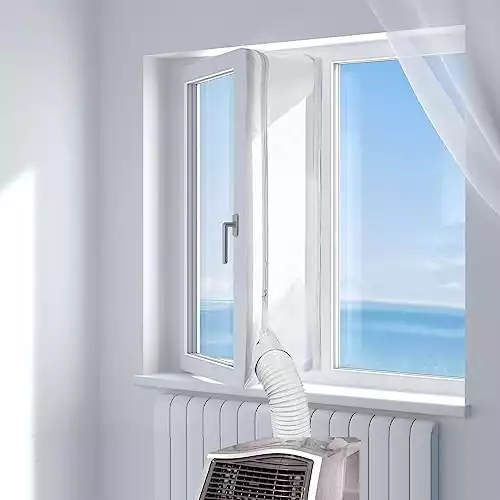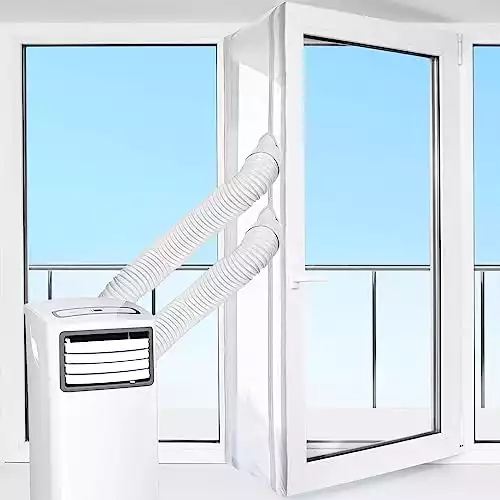HVAC Training Shop is reader-supported. As an Amazon Associate, I earn from qualifying purchases.
Venting your portable air conditioner is the most important thing you need to do for it to function properly.
Most people choose to vent their portable AC out of a window, which is one of the best options. But there are also other methods to vent your portable AC if there is no window.
In this article, I’ll go over a few different methods of venting your portable air conditioner. I’ll also go over the reasons why you need to vent your portable air conditioner.
Why you need to vent a portable air conditioner
If you have a portable air conditioner, you might wonder why you need to vent it in the first place. In fact, venting your portable air conditioner is necessary for it to work at all.
Why is that?
First, you need to understand how air conditioners work.
Air conditioners work by removing heat from the air and putting that heat in another place. When an air conditioner cools your room, it transfers the heat from inside your room to outside your room.
If your portable air conditioner is not vented to another space, then the heat will go right back into your room. The result is that your AC won’t cool your space. In fact, it can make your room even hotter than it was before.
Besides removing heat from your room, venting your AC also removes moisture from your room. Air conditioners dehumidify the air when cooling. Some of this moisture is vented outside your room.
For these reasons, it is critical that you vent your portable air conditioner properly if you want to achieve maximum cooling.
How to vent a portable air conditioner through a window
If you have a window in your home, then venting your portable air conditioner through it is one of the simplest options.
Most people choose to vent their portable air conditioner through a window. In fact, most portable air conditioners come with a vent kit that can be set up for this purpose.
Sliding windows offer the simplest setup. Casement windows can bit a bit more complicated but are still a great option.
Venting a portable air conditioner through a sliding window
Venting through a sliding window is the simplest solution for your portable air conditioner. The main reason is that you can slide the window partially up, and then set up the exhaust hose in the open area.
Another great reason to vent your portable air conditioner through a sliding window is the ease of installation. In most cases, you just need to slide the window up, install the vent kit, and then slide the window back down. This will hold the vent kit in place between the window and the window frame.
In many cases, venting your portable AC through a sliding window does not require any special tools or drilling. A lot of people install window vent kits for the hot months and then remove them after summer.
Venting a portable air conditioner through a casement window
Venting your portable air conditioner through a casement window is a little more of a challenge than a sliding window. This is because casement windows open like doors, so they swing on their vertical axis.
To vent a portable air conditioner through a casement window, you’ll need to remove the entire window from the frame. Then, replace the window with a layer of wood or plastic.
After you replace the casement window with a solid piece of material, venting is similar to the method of the sliding window. You’ll need to attach the window vent kit to the empty space at the bottom of the window.
It takes a little more work but by using this method you can vent your portable air conditioner through a casement window.
If you don’t want to go through the trouble of removing your window and installing a piece of wood, then there are other options. You can use a vent kit that is made for venting through a casement window.
This window vent kit seals your window, so you can install a portable AC vent in any type of window.
Venting a portable air conditioner through an awning window
Venting your portable air conditioner through an awning window isn’t as easy as venting it through a sliding window. But it’s also not as hard as venting it through a casement window.
To vent your portable air conditioner through an awning window, you need to first open the window and secure it so it doesn’t inadvertently shut.
You can use a screw to hold the window in the open position or use a piece of wood as a stopper to prevent it from closing.
I’ve vented portable ACs out of awning windows before, and some awning windows slide closed after a while. So that’s why it’s important to secure your awning window in the open position.
After the awning window is fixed open, use the venting panel from your portable AC’s venting kit to cover the open area on the awning window.
Use screws to secure the venting panel to the awning window.
If the venting panel that came with your portable AC isn’t large enough, then you can use a piece of plywood to fill in the rest of the gap.
Alternatively, a piece of plywood will suffice if you don’t have a venting panel at all.
After you mount the venting panel, attach the exhaust hose to the venting panel and your portable AC is ready to cool!
How to vent a portable air conditioner without a window
Sometimes, venting your portable air conditioner through a window is not an option. Particularly if you need to cool your basement or if the room is on the interior of your home.
In this case, you’ll have to vent your air conditioner elsewhere. I’ll go over a few different methods below.
Venting a portable air conditioner through a door
If the room that you are cooling has a door to another space, then this is a solid option for venting.
The first thing that you’ll need to ensure is that the space on the other side of the door will be okay with the increased temperatures.
This is not a problem if you’re venting the AC directly to the outside. But it can pose problems if you vent your portable AC to another room in your home.
When you vent a portable AC to another room in your home, it will get hotter from the vented heat. This is okay if you are venting the AC outside. But if you’re venting it into another room inside your house, make sure that nothing in that room can get damaged by the heat.
If you absolutely need to vent your portable AC into another room in your home, make sure that the room receiving the heat has a way to dissipate it.
If the room on the receiving end of the vent has a window, consider opening the window or using an exhaust fan to remove the hot air from the space.
You’ll also need to minimize air transfer between the conditioned and unconditioned spaces.
Using a universal door/window seal will prevent unwanted heat transfer back into the conditioned room. The seal covers up the big gap left by an opened door when you vent your portable AC through the door.
This vent kit is made for large windows— but also works for doors. Open your door and use the vent kit to form a seal for your portable AC.
Venting a portable air conditioner through a drop-ceiling
Venting your portable air conditioner through a ceiling tile or access panel is a solid option if a window isn’t available.
To use this method, you’ll need to cut a hole in the panel to put the hose through. You can also use a vent kit if you cut the panel down to allow enough space.
If you exhaust your portable air conditioner into the ceiling or attic, tread carefully. You will need to watch the temperature and humidity levels up in that space. Too much hot air in your attic can heat up the rest of your house.
The expelled moisture through the vent hose can also cause problems if you don’t completely vent it out of your home.
Some people that use this method will also install an attic exhaust fan. Using an attic exhaust fan will help remove the warm moist air completely from their home.
Connecting a portable air conditioner to a dryer vent
Connecting your portable air conditioner exhaust hose to a dryer vent is not the best option. This is because most dryer vents are smaller in diameter than an AC exhaust hose.
Connecting a large AC exhaust hose to a dryer vent will make the AC work harder to remove heat from your room.
This can be compounded by the presence of a flap on the dryer vent. Portable air conditioner exhaust is not powerful enough to blow open the flap on the dryer vent. So if you decide to hook up to a dryer vent, be sure that it has a screen and not a flap.
For these reasons, this method will usually work just fine. But there are better, more efficient venting options out there.
Venting a portable air conditioner through a wall
Venting your portable air conditioner through a wall is more of a last-ditch effort when there are no other options.
To vent your portable air conditioner through a wall, you essentially cut a hole in the wall and attach a venting kit to it.
This is undesirable for many reasons. First, you’ll need to make a hole in your wall. Another reason is that you may damage the wall when venting warm, moist air through it. Water damage can occur from the moisture of the hot, humid vent air.
How to use a portable air conditioner vent kit
Using a vent kit for your portable air conditioner is a good permanent solution for setting up a portable AC inside your home.
Depending on the make of the vent kit and what kind of surface you’ll be venting out of, the installation instructions may differ.
To use a portable air conditioner vent kit, you’ll want to consult its installation instructions. In the example below, we’ll go over the general steps you need to follow to vent your portable air conditioner through a sliding window:
- Measure your window and window vent kit. You’ll want to make sure that you open your window to the proper height for the exhaust hose to fit inside.
- Attach the window vent kit to the open space in the window. Make sure that there is a good seal between the window and the vent kit. You don’t want any insects or air transfer from the outside.
- Connect the exhaust hose to the vent kit. Once you have the window vent kit attached to your window, connect your portable air conditioner’s exhaust hose to it.
Can you vent a portable air conditioner through a screen?
Venting a portable air conditioner through a screen is not the ideal situation. No matter what, venting through a screen will reduce the effectiveness of your portable AC. But it can work very well in a pinch depending on the situation.
Ideally, you would remove the screen if you vent your portable AC through a window. But there are situations where removing the screen is not an option.
If you need to vent your portable air conditioner through a screen, you’ll need to ensure that the screen is clean. A dirty screen will impede airflow and reduce your air conditioner’s efficiency.
You also need to consider what type of screen it is. Thin screens will maximize airflow, while thick screens will impede airflow. So a thin screen is better. As a general rule of thumb, if you can clearly see through the screen, then it will be okay to vent your portable AC through it.
While venting a portable air conditioner through a screen, you will also need to periodically clean the screen. The screen will accumulate dust and debris from the airflow of the AC exhaust. Take a look at the screen at least every week and clean it if it gets dirty.
Can you vent a portable air conditioner through a return vent?
Venting a portable AC through a return vent is, for the most part, a bad choice.
Venting a portable air conditioner through a cold air return vent is a bad idea. This is because it will make your home’s central cooling system to work much harder.
As your portable AC dumps heat into the return vent, that heat goes back into your home’s central AC system. Your central AC system will have to also work to remove this heat from your home.
Basically, your home’s AC will be working twice as hard to remove heat from the space that you are cooling with the portable AC.
However, this method can work well if there are no other options to vent directly outside. If your home’s central AC system has enough capacity to remove more heat, then it should cause no issues.
As always, you should consult with an HVAC professional before attempting to do something like this.
In any case, venting a portable AC through a return vent should just be a temporary solution while you work on getting permanent means of venting in place.






Thank you for your assistance with this problem. have a horizontal awning window at the base of a larger picture window. I can’t remove the awning window, but can I still vent through a board cut to replace the screen for the opened awning window? I haven’t see this seemingly possible solution addressed anywhere.
Hi Gail,
Yeah, that’s a great solution for venting a portable AC out of an awning window. I’ll update the article.
Thanks,
-Trey
I have a different problem with my portable ac. How do we keep bugs (spiders and wasps) and these huge Cuban tree frogs from invading the exhaust? Also, there a deflector made to stop rain from blowing into it as well?
Hi Gary,
There’s nothing off-the-shelf that I’m aware of that can fix those problems. So you’ll need to get creative.
The first thing that comes to my mind for keeping out bugs is an aluminum mesh screen – similar to the stuff that’s used in screen doors but made out of aluminum.
For keeping the rain out, maybe try looking at those wall vents used for dryers.
Hope this helps,
-Trey
Question.
the central air a/c in our casita no long cools. Can I get a portable a/c and vent it into the ceiling return of my nonfunctioning central air a/c.
I intend to just have the portable a/c on and leave the central a/c unit off.
Hi Eddy,
That won’t work since the return duct of the AC goes back to the air handler, then to the supply vents in your home. The hot air will be directed back into your home.
-Trey
Thank you for the straight forward answer
So what if I ran the exhaust hose of the portable ac to the exhaust fan vent in the bathroom. I see this connects to the outside on my roof
I can remove the fan if needed so I don’t need to have the fan on in the bathroom the entire time. Would this work?
Hi Eddy,
Venting your portable AC out of your bathroom’s exhaust vent is not an ideal solution – but it should work. Depending on the length of the exhaust duct in your ceiling, you might need to run the exhaust fan to pull all of the exhaust air from the portable AC outside of your home.
-Trey
i installed a portable conditioner in my window but my security system did not work because the window has been secured by 2 buttons on the bard window. what should i do , please help me….. thank you. hh
Hi Nong,
If you want to install the portable AC vent on that window, you will need to reinstall the 2 “buttons” in such a way that they are in close proximity to each other when the window is closed. The “buttons” are a magnetic door switch that detects when your window is open for your security system.
Best of luck,
-Trey